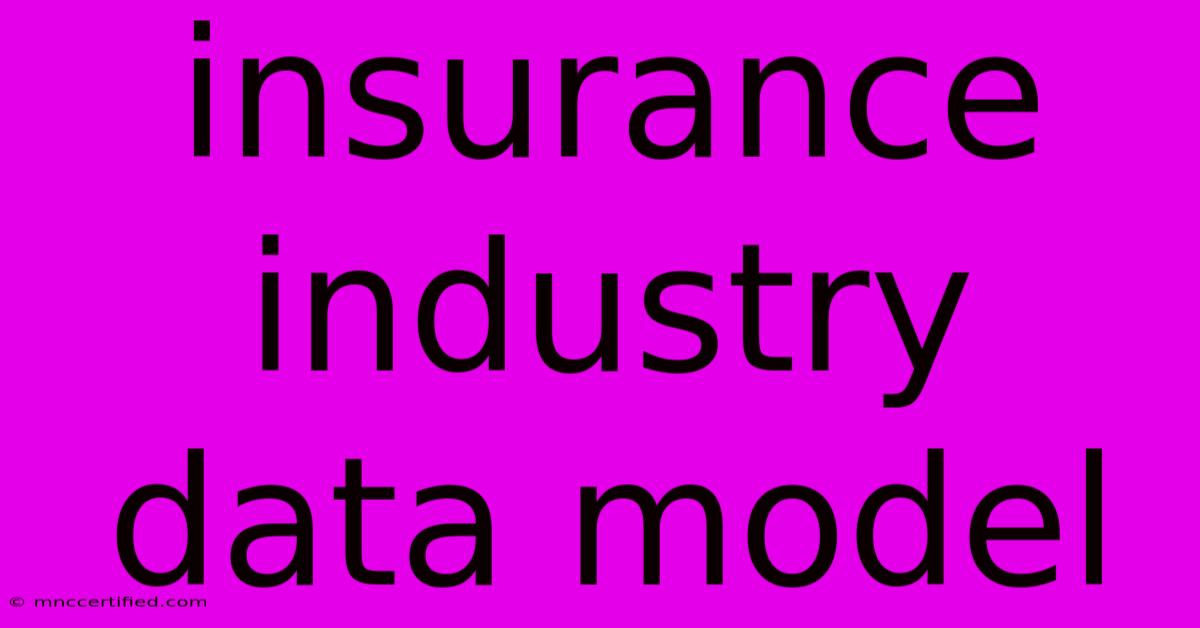Insurance Industry Data Model

Table of Contents
Insurance Industry Data Model: A Comprehensive Guide
The insurance industry is undergoing a massive digital transformation, driven by the increasing availability of data and advancements in technology. At the heart of this transformation lies the insurance industry data model, a crucial component for leveraging data effectively and driving innovation. This comprehensive guide will explore the key aspects of building and utilizing a robust insurance data model.
Understanding the Need for a Robust Data Model
Before diving into specifics, it's essential to understand why a well-structured data model is paramount for insurance companies. In today's competitive landscape, insurers need to:
- Improve Operational Efficiency: Streamline processes, reduce manual effort, and accelerate claims processing.
- Enhance Customer Experience: Personalize interactions, provide faster service, and offer tailored products.
- Mitigate Risk: Better assess and manage risk through advanced analytics and predictive modeling.
- Detect Fraud: Identify and prevent fraudulent claims more effectively.
- Gain Competitive Advantage: Leverage data insights to develop innovative products and services.
Key Components of an Insurance Data Model
A comprehensive insurance data model encompasses various data entities and their relationships. These typically include:
1. Policy Data:
- Policy Information: Policy number, effective date, expiration date, coverage details, premium amounts, payment history.
- Policyholder Information: Name, address, contact information, demographics, driving history (for auto insurance), risk profile.
- Vehicle Information (for Auto Insurance): Make, model, year, VIN number.
- Property Information (for Home/Property Insurance): Address, square footage, construction type, value.
2. Claims Data:
- Claim Number: Unique identifier for each claim.
- Claim Details: Date of loss, type of loss, location, description of damages, involved parties.
- Claim Status: Open, pending, closed, settled.
- Claim Payments: Amount paid, payment date, recipient.
3. Agent/Broker Data:
- Agent/Broker Information: Name, contact details, commission rates, assigned policies.
- Performance Metrics: Number of policies sold, claims handled, customer satisfaction ratings.
4. Financial Data:
- Premium Revenue: Total premium income.
- Claims Expenses: Costs associated with claims payments and investigations.
- Operating Expenses: Administrative costs, marketing expenses, etc.
Data Modeling Techniques for the Insurance Industry
Several data modeling techniques can be employed to build a robust insurance data model. These include:
- Relational Database Model: A traditional approach using tables and relationships to store data. This is widely used in the insurance industry due to its maturity and familiarity.
- NoSQL Databases: Suitable for handling large volumes of unstructured or semi-structured data, such as customer feedback or social media data.
- Data Warehousing and Data Lakes: These provide a centralized repository for storing and analyzing large datasets from various sources.
Choosing the right technique depends on the specific needs and resources of the insurance company.
Challenges in Implementing an Insurance Data Model
Implementing an effective insurance data model comes with its own set of challenges:
- Data Silos: Data scattered across different systems and departments.
- Data Quality Issues: Inconsistent data, missing values, and errors.
- Data Security and Compliance: Meeting regulatory requirements like GDPR and CCPA.
- Integration with Legacy Systems: Connecting new systems with existing legacy systems.
Best Practices for Success
- Start with a Clear Business Objective: Define specific goals you want to achieve with the data model.
- Involve Stakeholders: Engage representatives from different departments to ensure buy-in and alignment.
- Prioritize Data Quality: Implement data validation and cleansing processes.
- Choose the Right Technology: Select technologies that align with your needs and budget.
- Implement a Robust Data Governance Framework: Establish policies and procedures for data management.
Conclusion: The Future of Insurance Data Modeling
The insurance industry data model is not a static entity; it's constantly evolving. As new technologies emerge and data sources proliferate, insurers need to adapt and refine their data models to stay ahead of the curve. By embracing best practices and leveraging modern technologies, insurance companies can unlock the full potential of their data and gain a significant competitive advantage. The future of insurance is data-driven, and a robust data model is the foundation for success.

Thank you for visiting our website wich cover about Insurance Industry Data Model. We hope the information provided has been useful to you. Feel free to contact us if you have any questions or need further assistance. See you next time and dont miss to bookmark.
Featured Posts
-
Second Touchdown Goff Finds La Porta
Nov 29, 2024
-
Nashville Term Life Insurance
Nov 29, 2024
-
Insurance Agent Paid Training
Nov 29, 2024
-
10 Top Walmart Black Friday Deals 2024
Nov 29, 2024
-
Gap Addendum Vs Gap Insurance
Nov 29, 2024